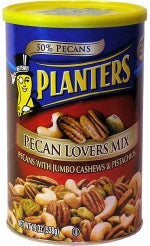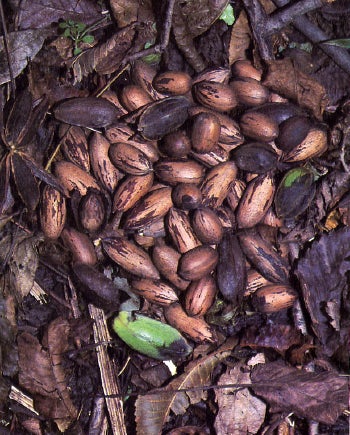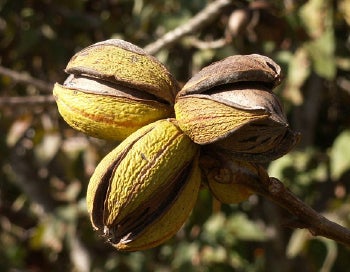
La página que intenta visitar sólo está disponible en inglés. ¡Disculpa!
The page you are about to visit is currently only available in English. Sorry!

 |
You probably don't. Contemplate pecans, that is. Except maybe in the holiday season, when bowls of deluxe mixed nuts (no peanuts) are strategically placed around cocktail parties, while open bins of unshelled walnuts, pecans, almonds, hazelnuts and Brazil nuts compete for your attention at the produce market. Indeed, when I was growing up in Michigan, my dad always brought home an assortment of hard-shelled tree nuts at Christmas time, Carnation Milk's annual gift to employes at the condensery over by the railroad tracks. We'd sit at the kitchen table with a nutcracker and picks, trying our best to remove the walnut and pecan halves in one piece but seldom succeeding. For as any nut lover will tell you, those sweet, buttery meats are the real prizes in the assortment.
Most of the nuts mentioned above are grown commercially, the exception being the Brazil nut, which has defied cultivation. Those heavily armored fruits fall from massive, centuries-old trees in the Amazon rainforest. Almonds, of course, come from California orchards but the tree itself originated in Near East lands like Iraq that in my youth were only mysterious blocks of color on a library globe. There were shrubby stands of American hazelnuts at the edge of my favorite squirrel-hunting woods, to the delight of not only bushytails but chipmunks, jays, grouse and deer. However, the "filberts" found in Planters cans come from a closely related Old World species nutured on groves in the Pacific Northwest.

Which leaves walnuts and pecans, both of which are borne on native trees. Black walnuts were fairly common in lower Michigan and a sturdy specimen shaded my best friend's backyard, littering the grass in autumn with rough-shelled nuts encased in thick, yellowish-green hulls that ooze a smelly brown juice as they soften. As the naturalist Hal Borland wrote in our book A Countryman's Woods, "anyone who picks or hulls walnuts has dark-dyed hands that do not bleach back to normal color for weeks." Pecan country, however, seemed as remote to me as the Amazon basin. The largest and longest-lived tree in the important walnut-hickory family, the pecan thrives on the rich, moist bottomlands of the Mississippi River Valley, from Illinois to the Gulf of Mexico. And 30 years passed before the eloquent story-teller John Madson, a frequent Audubon contributor, pointed his outboard into a slough on the Missouri side of the big river, leading me to a stand of towering pecans where dark-brown nuts up to 2.5 inches long littered the forest floor.

They were impressive trees indeed. A 300-year-old pecan might stand 200 feet tall with a straight trunk 8 feet in diameter and produce up to 1,000 pounds of nuts per year. The fruits, clustered in groups of 3 to 6, are covered with thin husks that break into four sections to release the nuts in September or October. Unlike walnut, which is worth its weight in gold, pecan wood has relatively few uses. But it is no exaggeration to say that Carya illinoensis is one of the most valuable cultivated plants of North American origin. Wild pecans (and walnuts, too) still reach the marketplace. But most of the pecans we consume today come from thin-shelled varieties grown on plantations in the Southeast.

That's a good thing. As Borland noted, the oldtime way of harvesting wild pecans "now seems unbelievable. Nut-gatherers went through the woods, chose the largest, heaviest-bearing pecan trees, and when the nuts were ripe they cut them down. Then they put boys to work picking the nuts from the fallen giants. Not until those magnificent pecan trees became scarce did they cease cutting them and begin grafting and planting new trees that are grown in orchards like oranges."